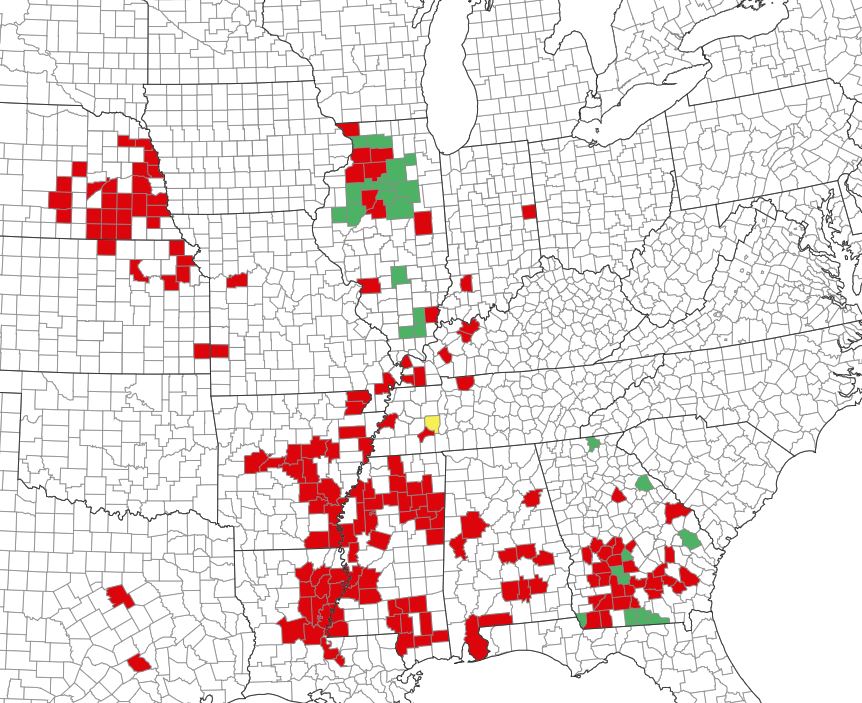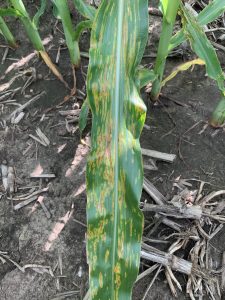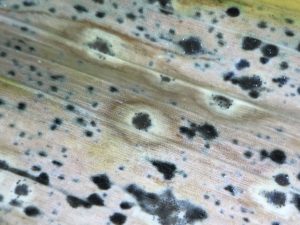Southern rust is caused by the obligate fungal pathogen Puccinia polysora. Puccinia polysora produces fuzzy, raised structures called pustules on leaves and stalks of corn. Pustules contain thousands of small orange spores. When you rub these pustules between your fingers, the spores may leave a dusty orange coat on your fingers, hence the reason it is called a “rust.” Pustules of Southern rust are orange to light tan, and often small and circular. Pustules are mostly found on the upper leaf surface, which can help distinguish it from the less damaging common rust.
Spores from pustules can be dispersed miles on air currents, allowing the disease to spread rapidly. Under hot humid conditions, spores of the fungus can infect susceptible corn, and symptoms can be observed within 3-4 days. Within 7-10 days, spores are produced and can be dispersed. The cycle of spore-infect-spore can continue as long as conditions are conducive and corn plants are green. Conditions that favor disease development include hot temperatures (morning low of 75°F and daytime high of 93°F) and at least 4 hr of consecutive leaf wetness. Outside of these conditions disease progress can occur, but at a slower rate. Our colleagues to the South state that Southern rust can continue chugging along at 110 degrees. That’s pretty impressive.
Southern rust does not overwinter in Illinois and blows into the region from warmer regions. In years where it develops to a significant degree early in southern regions, it can move into Illinois during critical stages in crop growth. In general, we see the disease move in most years in late July or early August. This means that in years when plantings are delayed, the disease can arrive on time but plants may be at greater risk for yield loss because the earlier infections occur the more yield can be impacted. Experience from our Southern colleagues indicates that stalk integrity isn’t likely to be affected unless you see significant infections during the vegetative stages of crop development.
Example lifecycle of Southern rust. Note that it blows in from warmer, southern regions. From Crop protection network
Now that we are on the same page about this disease, what about management? Let’s start by considering management decisions. Below is a table modeled after one produced by fellow plant pathologist Travis Faske at the University of Arkansas, depicting the likelihood that a fungicide application for Southern rust will provide a benefit:
| Growth Stage | Southern rust present | Forecast favors S rust (75-93F) min 4 hrs leaf wetness | Benefit of fungicide? |
| Vegetative | yes | yes | yes |
| VT/R1 | yes | yes | yes |
| R3 | yes | yes | yes |
| R4 | yes | yes | Unlikely |
| R5 | yes | yes | No |
| Maturity | yes | yes | No |
Experience from the South indicates that trying to hold off an application until VT/R1 if possible is going to give you the highest likelihood of coming out even or ahead of this disease. If you apply during the vegetative stages, realize that that means that you might need to come back again and make a second application. You now have likely doubled your application costs.
Our colleagues in Louisiana developed a southern rust risk calculation sheet to help producers determine if management is required. This can be accessed by clicking here.
Last season we had an opportunity to conduct a fungicide trial in Carmi, IL, where Southern rust was starting to develop on a susceptible hybrid right as plants were approaching VT. In addition, this was an irrigated field, and the farmer/cooperator ensured that plants were receiving adequate water during periods of hot, dry conditions. This therefore, helped facilitate disease development. The takehome was that a well timed fungicide can benefit if southern rust arrives and conditions are conducive for disease, but avoid utilizing a cheap propiconazole product. To access a pdf of these results click this link: Doc1
Southern rust has been detected throughout the state, and incidence and severity in the northwest part of Illinois has increased with favorable weather over these past 2 weeks.

You can track disease occurrence in real time by accessing the corn IPMPIPE page here. Remember that P. polysora is an obligate pathogen and needs to blow into the state each season, unlike grey leaf spot or even tar spot. Thus, by paying attention to where the disease is, knowing your hybrid, and knowing the stage of growth, you can make informed within management decisions.
Lastly, it is important to accurately identify the disease. If you are not sure, or want an expert opinion, send samples to the UIUC plant diagnostic clinic.
Let’s hope for a productive 2020!



